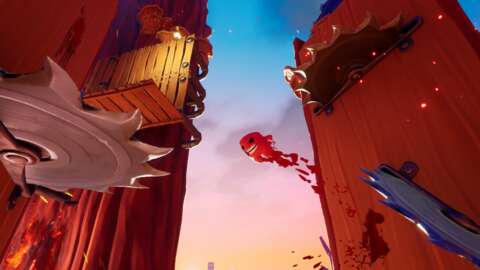Super Meat Boy is the poster child for tough-as-nails precision platforming. The 2010 2D platformer starring a slab of meat was a viral hit in part because the game knew how difficult it was, and emphasized your repeated deaths by showing you each of them simultaneously once you finally completed a level. I’ve been curious to see how that 2D precision would translate into the realm of a 3D platformer. Unfortunately, based on a brief gameplay demo, the answer is: not very well.
My demo covered the earliest stages of the game, from a handful of tutorials through a few longer levels covered with traps and hazards. And to its credit, Meat Boy 3D nails the fundamentals of what you would expect from a Super Meat Boy game. You’re once again a squishy, squelchy slab of unidentified, bloody meat, running through hazard-filled stages to save your girlfriend, Bandage Girl, from the evil Dr. Fetus. At the end of every stage, you reach Bandage Girl, only to have Dr. Fetus snatch her away to the next stage. Then you get to watch a replay simultaneously showing your every attempt, with many Meat Boys scrambling ahead and all but one of them meeting their grisly doom, summarizing your journey through the stage. The irreverent humor is all very recognizable, even including a little warp pipe gag to reference Meat Boy’s Super Mario Bros. inspirations.
While you have full 3D control, in the early stages I played, the layouts lent themselves to the eight cardinal directions. Like its predecessors, Super Meat Boy 3D is focused on pushing you to move through levels as fast as possible–the tutorials introduce the dash button early, and you can’t really get enough momentum for most jumps without it–and you’re mostly going in straight lines or diagonals. Presumably this is to keep these early stages easily readable and to avoid overwhelming the player with too much freedom of movement before they really get a feel for it.




It’s interesting to see how beloved games like Super Meat Boy are evolving into 3D. The challenges of transitioning a classic to a new dimension can lead to mixed results, but it’s always exciting to explore new possibilities in gameplay. Looking forward to hearing more thoughts on this!
Absolutely, it’s fascinating to witness this evolution! Transitioning to 3D can introduce new mechanics and challenges, but it also risks losing the tight controls that made the original so enjoyable. It’ll be interesting to see how the developers balance those elements in future iterations.
You’re right! The shift to 3D definitely opens up different mechanics, but it can also complicate the tight controls that fans love. It’ll be interesting to see how they balance the classic gameplay with new 3D elements.
Absolutely, the transition to 3D can introduce exciting new elements, but it can also dilute the tight controls that made the original so engaging. Balancing those mechanics while maintaining the core experience is a real challenge. It’ll be interesting to see if they can find the right formula!